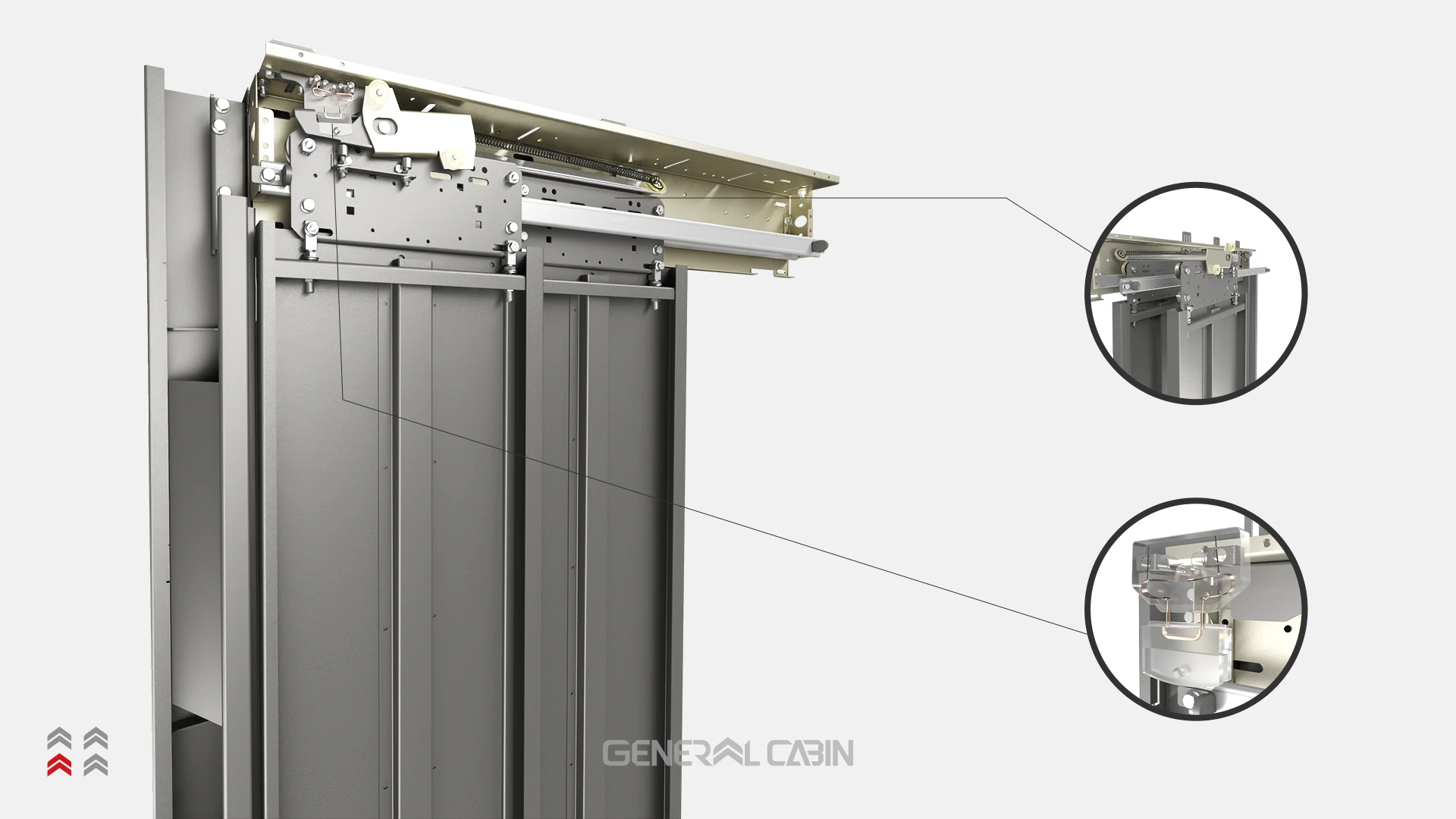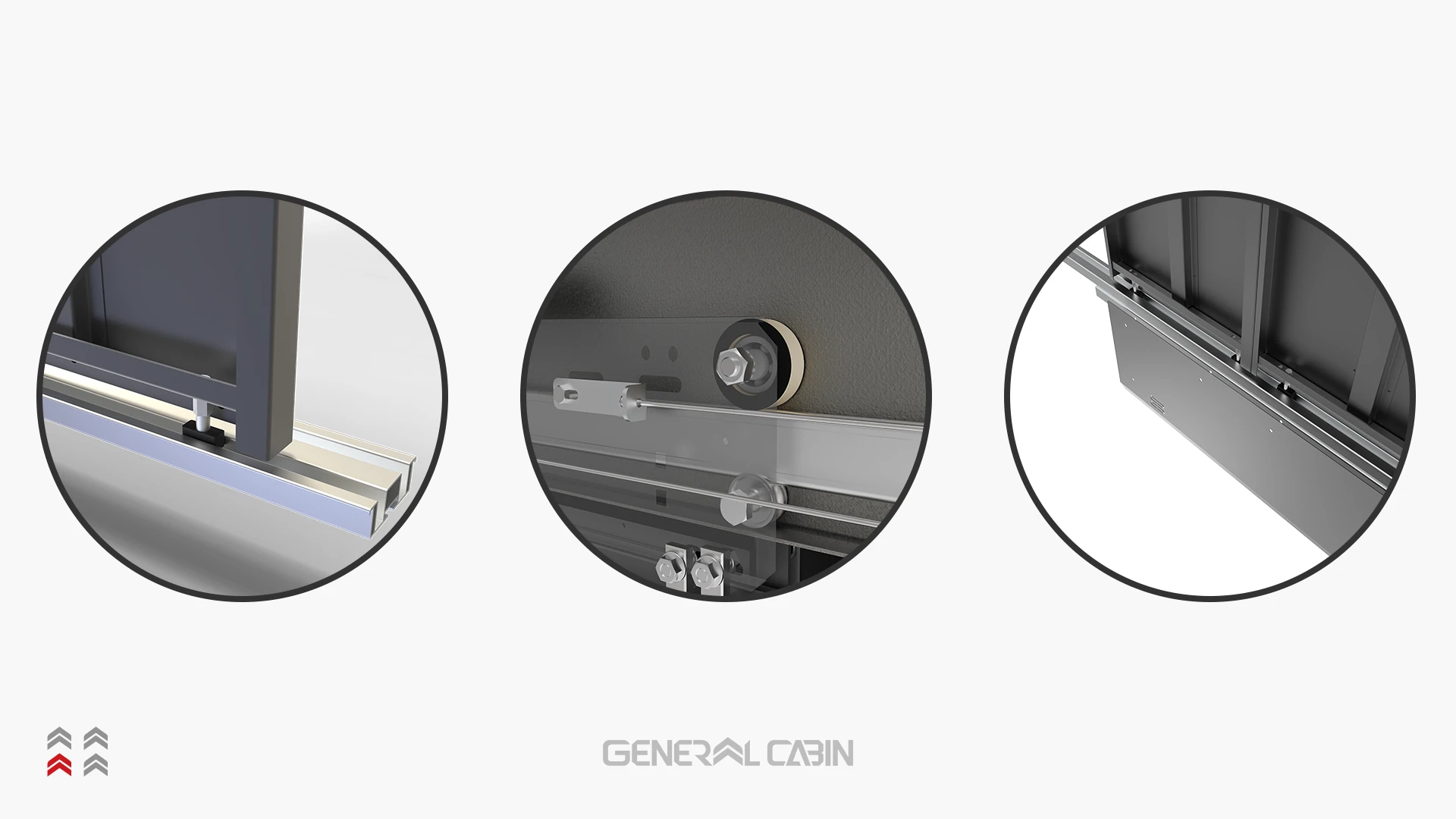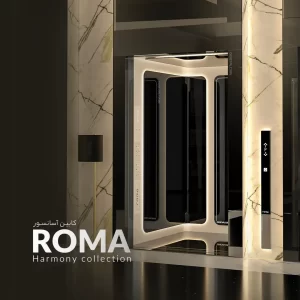
Elevator Doors
The elevator door is a vital and fundamental element in any elevator system, serving as an interface for passengers to enter and exit and responsible for their safety and well-being. Therefore, their installation and adjustment are of particular importance. Careful attention must be paid to their installation, much like other mechanical components of the elevator, as even the slightest mistake can lead to serious damage. Elevators generally have two types of doors: floor doors installed for each floor and cabin doors mounted on the elevator car.
Components of Elevator Doors:
- Door Panels: Elevator cabin doors are made up of various components, each serving specific functions in operation and safety of the elevator.
- Rails: Rails are crucial in the smooth and reliable movement of elevator cabin doors. These rails are made of steel or aluminum and are installed on the cabin’s base or elevator walls.
- Locking System: The locking system of elevator cabin doors is responsible for preventing unauthorized opening of the doors during elevator movement. This system typically includes locks, pins, and locking mechanisms.
- Motors: Motors electrically operate the opening and closing of elevator cabin doors. These motors usually operate linearly or rotarily and can be controlled using hydraulic or electric systems.
- Sensor Systems: Sensors are typically installed on elevator cabin doors to detect the door’s status and regulate its proper functioning. These sensors include pressure, motion, magnetic, and light sensors.
- Control System: This component is responsible for controlling the opening and closing of doors. The control system usually comprises controllers, electronic circuits, and control switches.

Types of Elevator Doors
- Based on Installation Location:
- Cabin Doors: These doors are directly mounted on the elevator car and separate the cabin from the external environment by opening and closing.
They ensure the safety and well-being of passengers and prevent people from entering the elevator shafts.
These doors are usually made of metal and have various safety features. They open and close horizontally and are equipped with locking systems and sensors that control their operation.
The design and strength of these doors are crucial, as any defects or weaknesses in them can pose risks to passengers.
They typically feature control panels and decorations for aesthetic appeal and to match the overall appearance of the elevator.
Cabin elevator doors are used for passengers and cargo to enter and exit the elevator.
- Landing Doors: These doors are located on each floor of the building and their opening and closing determine which floor is accessible.
Safety of these doors is also crucial; if the landing door is not open and the elevator car stops there, passengers cannot enter or exit.
The proper functioning of these doors requires proper adjustment and coordination with the movement of the elevator car to prevent accidents.
Some landing doors are equipped with additional features such as motion sensors or automatic locks to enhance the safety and efficiency of the elevator.

2. Based on Operation Method:
- Fully Automatic: These doors open and close completely automatically without the need for manual intervention.
Typically, using sensors or electronic controls, fully automatic doors open automatically when approached and close automatically after passengers enter the cabin.
Fully automatic elevator doors are used for both cabin and floor doors.
The components of fully automatic elevator doors include contacts, shoes, door seals, panels, and frames.
Features of fully automatic elevator doors include:
Sound insulation, making sounds emitted from the elevator shaft inaudible inside the cabin.
They are made using bearing pipes.
The left and right doors are identical.
They are made using foam ball trays.
These doors have a very stylish and impressive appearance.
This type of door is generally used in modern elevators employing advanced technologies.
- Semi-Automatic:
Semi-automatic doors operate with a combination of automatic and manual elements and are commonly used in smaller elevators or buildings where full automatic doors cannot be installed.
Features of semi-automatic elevator cabin doors include:
Manual Opening and Closing: Semi-automatic doors often require pressing specific buttons for opening and closing manually. This allows users to open or close the door for entering and exiting the cabin by pressing the buttons.
Use of Automatic Elements: Semi-automatic doors generally come with automatic elements such as sensors and locking mechanisms to provide optimal performance and higher safety.
Suitable for Limited Spaces: Due to not requiring large spaces for installation and operation, semi-automatic doors are suitable for small elevators or buildings with spatial constraints.
Use in Various Elevators: These doors are used in residential, commercial, and even industrial elevators, provided that the conditions for installing fully automatic doors are not available.
- Collapsible or Manual:
Collapsible doors are a type of floor doors that are installed easily and at minimal cost. These doors do not require a large width space because they consist of a simple door and frame. However, the main drawback of these doors is that when opened to a 90-degree angle relative to the wall, they can obstruct the corridor. Therefore, these doors are particularly suitable for elevators intended for a limited number of stops and seeking a simple and inexpensive solution. Collapsible doors also have other issues, such as a lack of control over the opening and closing time. This issue can affect the elevator’s cycle and lead to increased traffic in the building.

- Based on Opening Mechanism:
- Central (folded from the middle to both sides): In this type of door, the panels open and close from the middle to the edges on both sides. This type of door is usually used in smaller elevators or in cases where lateral space is limited.
- Telescopic (folded to one side): In telescopic doors, the panels open and close to one side from the middle. This type of door is suitable for use in elevators with sufficient lateral space.
- Central-Telescopic (in models with 4 panels and above): This type of door is used in models with 4 panels and above. The panels open and close from the middle to both sides, but each of them is structurally telescopic.
- Bus: This type of door is used in models with 4 panels and above. The panels open and close from the middle to both sides, but each of them is structurally telescopic.
- Guillotine (upward folding): This type of door is used in models with 4 panels and above. The panels open and close from the middle to both sides, but each of them is structurally telescopic.
- Based on Material (In Various Colors):
- Steel with Color Coating
- Steel with Stainless Steel Coating
- Full Stainless Steel
- Full Glass
- Steel and Glass

Technical Specifications of Elevator Cabin Doors
Elevator cabin doors can have windows that allow passengers to see the outside environment. These doors play a crucial role in the safety and proper functioning of the elevator and should be periodically inspected and maintained. Elevator cabin doors are usually designed and manufactured in various dimensions, sizes, and models, including automatic, semi-automatic, and collapsible models, allowing passengers to enter and exit the elevator. These doors can be opened and closed automatically or manually, allowing passengers to enter and exit easily and safely. This elevator component typically has larger dimensions and provides better accessibility for individuals.
Technical Information of Elevator Cabin Doors
- Dimensions: The dimensions of elevator cabin doors should be proportionate and compatible with the dimensions of the elevator cabin. These dimensions are usually determined by the width, height, and thickness of the door.
- Material: Elevator cabin doors are usually made of metal (stainless steel or aluminum) and should be resistant to impact, heat, and corrosion.
- Opening and Closing System: Doors can open and close horizontally, and this system includes rails, motors, and locking mechanisms.
- Locking System: The locking system of elevator cabin doors prevents unauthorized opening during elevator operation and can operate electromechanically or mechanically.
- Security: Elevator cabin doors feature security measures such as emergency locks, alarm systems, and child locks to prevent accidents.



